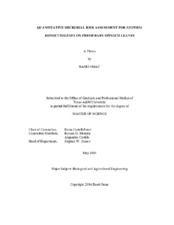| dc.description.abstract | The increase in foodborne illness outbreaks associated with leafy green vegetables can be attributed to the minimal processing required of this group of fresh produce. Neglecting effective microbial elimination steps result in leafy green vegetables that naturally contain microorganisms such as pathogens microorganisms. This quantitative microbial risk assessment describe the change of L. monocytogenes concentration in fresh baby spinach from farm to table. This model also consists of several scenarios to evaluate decontamination treatments, cross-contamination, and temperature abuse.
Cross-contamination was the biggest issue when ensuring safety of leafy green vegetables. Temperature abuse also increased the risk of listeriosis. On the other hand, irradiation treatment with Modified Atmosphere Packaging reduced the number of annual cases of listeriosis by 99.99%.
In addition, the validation of L. innocua used as a surrogate for L. monocytogenes in fresh baby spinach was evaluated based on reductions by washing (water and chlorine) treatments and growth at temperatures between 5 and 36oC. According to the results of the washing treatments, the concentration of L. innocua was reduced by almost 0.5 log CFU/g. This is more than that of L. monocytogenes.
Furthermore, the effect of natural background microflora on the growth of L. monocytogenes and L. innocua in fresh baby spinach was determined. The results showed that the growth of L. innocua was affected more than that of L. monocytogenes at temperatures 10> T >30^(o)C. Although L. innocua and L. monoctogenes are genetically similar, their behavior changes under stress conditions.
Ultimately, the dynamic growth models for L. monocytogenes in fresh baby spinach was presented. These models can be used to estimate the growth of L. monocytogenes in fresh baby spinach during distribution, storage or market, and potential growth at a consumer level. | en |


